
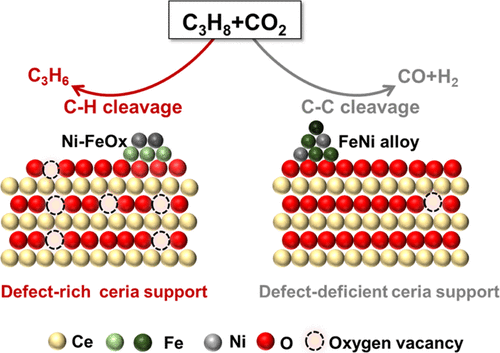
Yehong Wang, Zhixin Zhang, Lijun Lei, Wen Liu, Shuyan Du, Xiangxue Zhu, Xiujie Li*, and Feng Wang*
ACS Sustainable Chem. Eng., 2021, 9, 17301-17309
In this work, we developed a strategy to realize selective C–H/C–C bond cleavage of propane with CO2 as the oxidant by controlling the defect concentrations of ceria supports over FeNi/ceria catalysts. Two types of ceria with distinct defect concentrations were prepared successfully. The propane conversion achieved 25.2% with 49% propylene selectivity via C–H bond cleavage over the defect-rich ceria-supported FeNi catalyst at 550 °C. In contrast, CO is generated via C–C bond cleavage with 95% selectivity when defect-deficient ceria was used as the support. The essential role of defects in the ceria support was investigated carefully by UV–Raman, X-ray photoelectron spectroscopy, and H2-temperature-programmed reduction. This work provides a method for defect tuning of ceria-based catalysts and realizes the selective conversion of CO2 and alkanes to value-added chemicals.
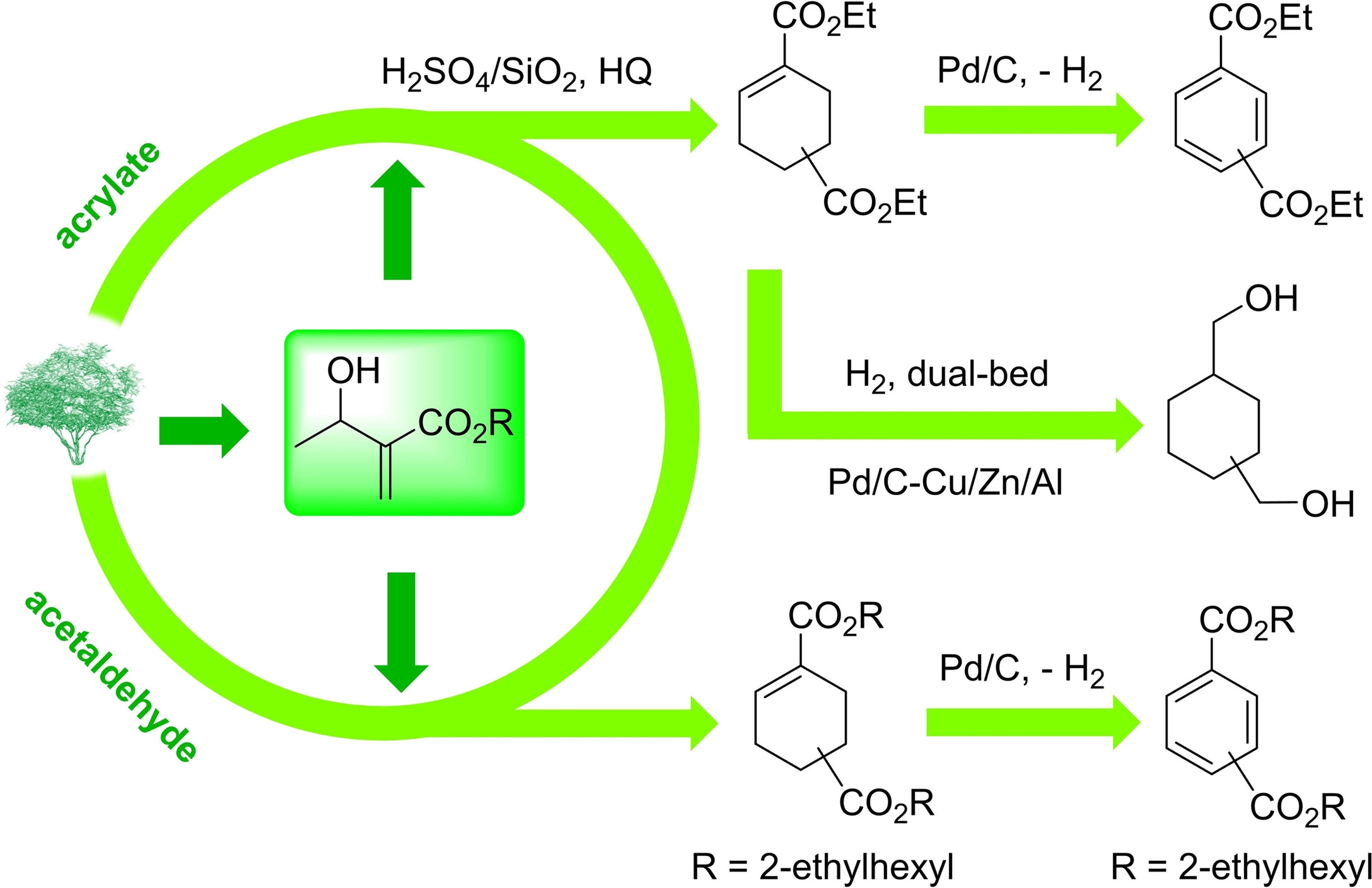
Lin Yuan#, Yancheng Hu#, Zhitong Zhao#, Guangyi Li, Aiqin Wang, Yu Cong, Feng Wang*,Tao Zhang*, and Ning Li*
Angew. Chem. Int. Ed., 2021, 61, e202113471:1-5
PCTA is an important copolyester that has been widely used in our daily necessities. Currently, its monomers are industrially produced from petroleum-derived xylene. To reduce the reliance on fossil energy, we herein disclose an alternative route to access PCTA monomer (terephthalate/isophthalate=2.4/1) in 61 % overall yield using plant-based acrylate and acetaldehyde as the feedstocks. The process includes Morita–Baylis–Hillman (MBH) reaction of acetaldehyde with acrylate, subsequent one-step dehydration/Diels–Alder reaction with acrylate over H2SO4/SiO2 catalyst, and final Pd/C-catalyzed dehydrogenation. Besides, when varying the final step to hydrogenation, another important monomer UNOXOL™ diol (1,4-trans/1,4-cis/1,3-trans/1,3-cis=5.2/2/2.5/1) can be produced in 67 % overall yield.
Tingting Hou#, Zhuyan Gao#, Jian Zhang, Nengchao Luo, and Feng Wang*
Trans. Tianjin Univ., 2021, 27, 331–337
Herein, we constructed N-doped TiO2 nanotubes (N-TNTs) that exhibited remarkable activity and selectivity for toluene oxidation under visible light, delivering the conversion of toluene and selectivity of benzaldehyde of 32% and > 99%, respectively. Further mechanistic studies demonstrated that the incorporation of nitrogen induced the generation of N-doping level above the O 2p valance band, directly contributing to the visible-light response of TiO2. Furthermore, hydroxyl radicals generated by photogenerated holes at the orbit of O 2p were found to be unselective for the oxidation of toluene, affording both benzaldehyde and benzoic acid. The incorporation of nitrogen was able to inhibit the generation of hydroxyl radicals, terminating the formation of benzoic acid.
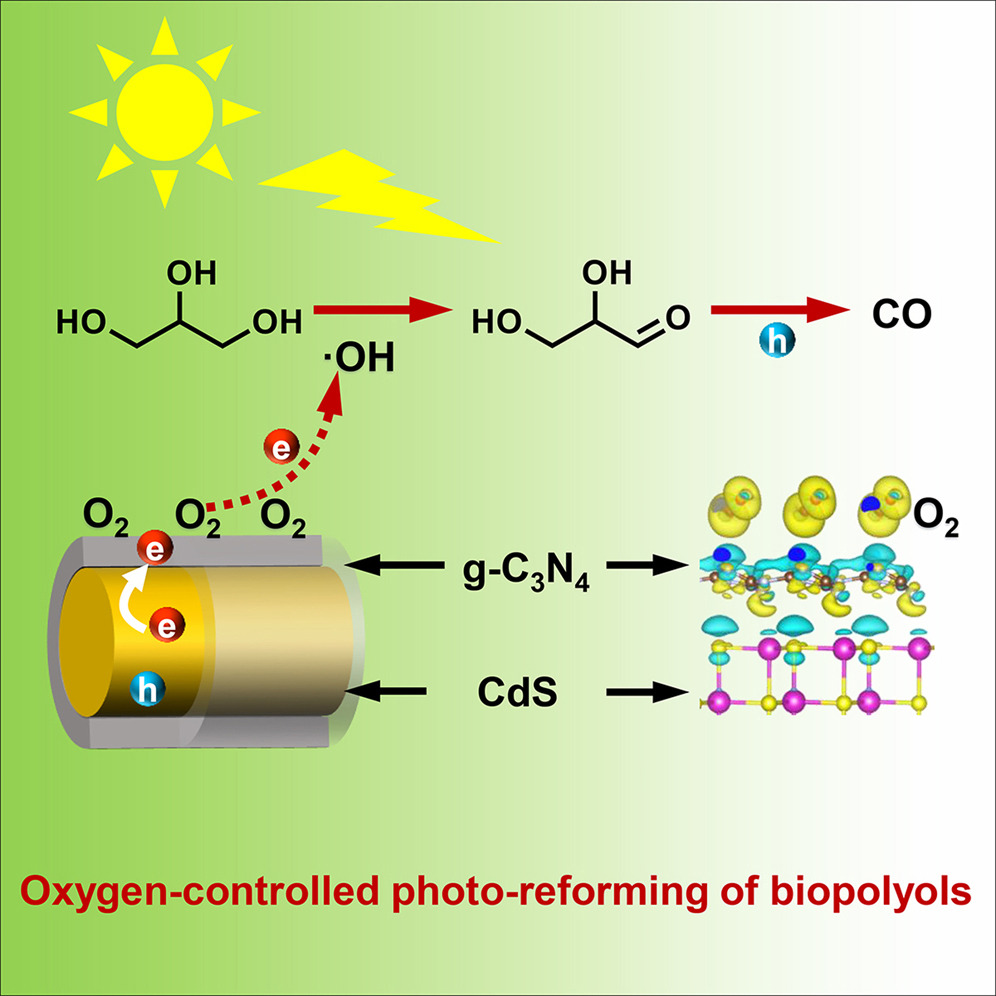
Hongru Zhou, Min Wang*, and Feng Wang*
Chem., 2021, 8, 465-479
Carbon monoxide (CO) is a large-scale feedstock and fuel, which is industrially produced from steam reforming of coal and methane at high temperatures. Photocatalytic CO production from biomass at room temperature is a promising route but still shows low activity. Targeting this problem, we propose an oxygen-controlled photo-reforming method to promote CO evolution from biopolyols and sugars. Appropriate O2 content turns the reaction into thermodynamically favorable, thus accelerating the CO generation rate. A core-shell structure Z-scheme CdS@g-C3N4 was prepared as the photocatalyst. The particular catalyst structure facilitates the adsorption and activation of dioxygen, thus accelerating the CO evolution.
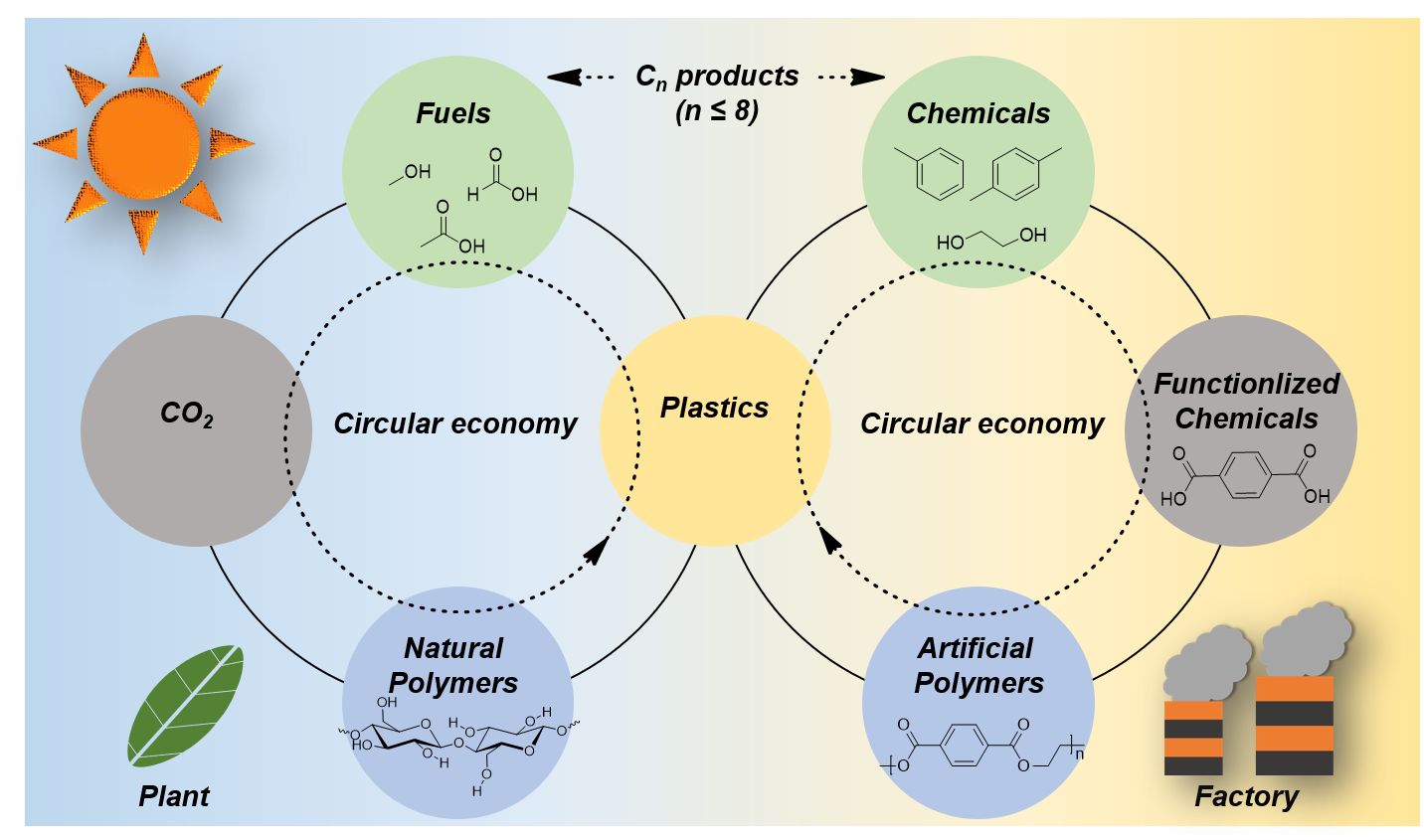
Kaiyi Su, Huifang Liu, Chaofeng Zhang, and Feng Wang*
Chin. J. Catal., 2021, 43, 589-594
As a great threat to all livings on earth, waste artificial plastics now are everywhere, from oceans to our cells. The world cannot withstand the growing waste plastic in million tonnes every year, which has already caused environmental pollution and economic losses. Besides the efforts for preparing novel plastics with the self-decomposition ability, the world needs methods to clear away these waste plastics leftover from history or recycle well this organic carbon resource. Photocatalysis is a potential solution for the conversion of waste plastics under mild conditions. In this perspective, we highlight the effect of photocatalytic approaches toward the generation of low carbon number organic products (Cn products, n ≤ 8) from waste plastics, which can proceed under an inert or aerobic atmosphere. Notably, critical analysis of the carbon source in products is necessary to reveal the active species for the C–X bonds (X = C, N, and O) cleavage of plastics... ...

Dongxia Jiao, Yehong Wang*, Zhixin Zhang, Jian Zhang, Lijun Lei, and Feng Wang*
ChemCatChem, 2021, 13, 4159-4163
Formamide is an important solvent and synthetic intermediate. Herein, we designed a hydroxyapatite (HAP)-stabilized, positively charged Ru-based catalysts which can efficiently catalyze the formylation reaction of amines with CO for the synthesis of formamide. The Ru-HAP showed excellent catalytic performance in N,N-Dimethylformamide (DMF) synthesis, with about 75% DMA (dimethylamine) conversion and >99% DMF selectivity at 300 h of continuous reaction. The combination of characterization results and control experiments showed that positively charged Ru species, including hydrated RuO x and Ru 3+ species, were catalytically active. In particular, the surface RuO x species were more active than the Ru 3+ species located within the HAP framework.
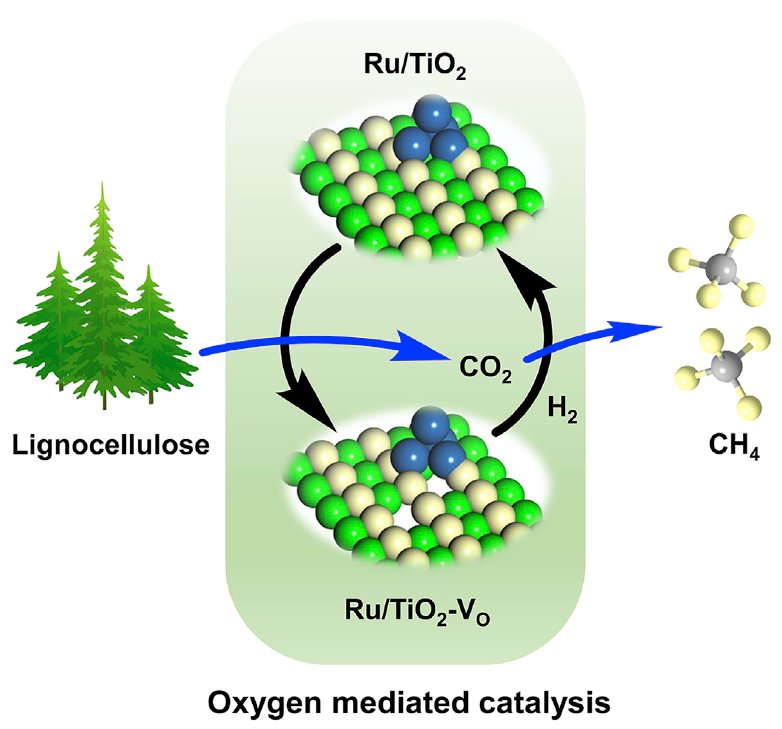
Hongru Zhou, Min Wang*, and Feng Wang*
Joule, 2021, 5, 3031-3044
Biomethane is a clean energy and a key platform chemical for modern chemical industries. The conversion of biomass, especially the most abundant lignocellulose, into biomethane is challenging and shows low selectivity either in chemical or biological processes. Herein, we report the direct methanation of biomass at temperatures below 200°C with >95% selectivity using interfacial oxygen-vacancy (VO)-mediated catalysis over Ru/TiO2. The biomass feedstock is oxidized by TiO2 to form CO2 and VO, and CO2 is then in situ reduced on Ru sites to CH4, restoring the oxygen to VO simultaneously. Various biomass resources were converted into methane with 82%–99% yields. Even lowering the temperature to 120°C, about 0.24 mmol g−1 h−1 of CH4 with >99% selectivity was steadily produced from 50 wt % aqueous glycerol for 432 h. In situ X-ray photoelectron spectroscopy, infrared spectrometry, and DFT calculation confirm the VO-mediated catalysis process over Ru/TiO2.

Kaiyi Su, Yehong Wang, Chaofeng Zhang, Zhuyan Gao, Jianyu Han, and Feng Wang*
Appl. Catal. B-Environ., 2021, 298, 120554
Herein, we reported the tuning of dominant products in the photocatalytic hydrogen transfer reaction over Pt/Nb2O5 photocatalysts, using a support-induced modification strategy. In the photocatalytic conversion of phenylacetylene with ethanol as a probe reaction, the dominant product was styrene over Pt/2D Nb2O5 nanoplates; in contrast, H2 was the main product over the Pt/bulk Nb2O5. Compared to the metallic Pt species over bulk Nb2O5, the positively charged Pt (Ptδ+) species over 2D Nb2O5 nanoplates contributed to the reduction of phenylacetylene, which was revealed by CO adsorbed Fourier transform infrared spectra.
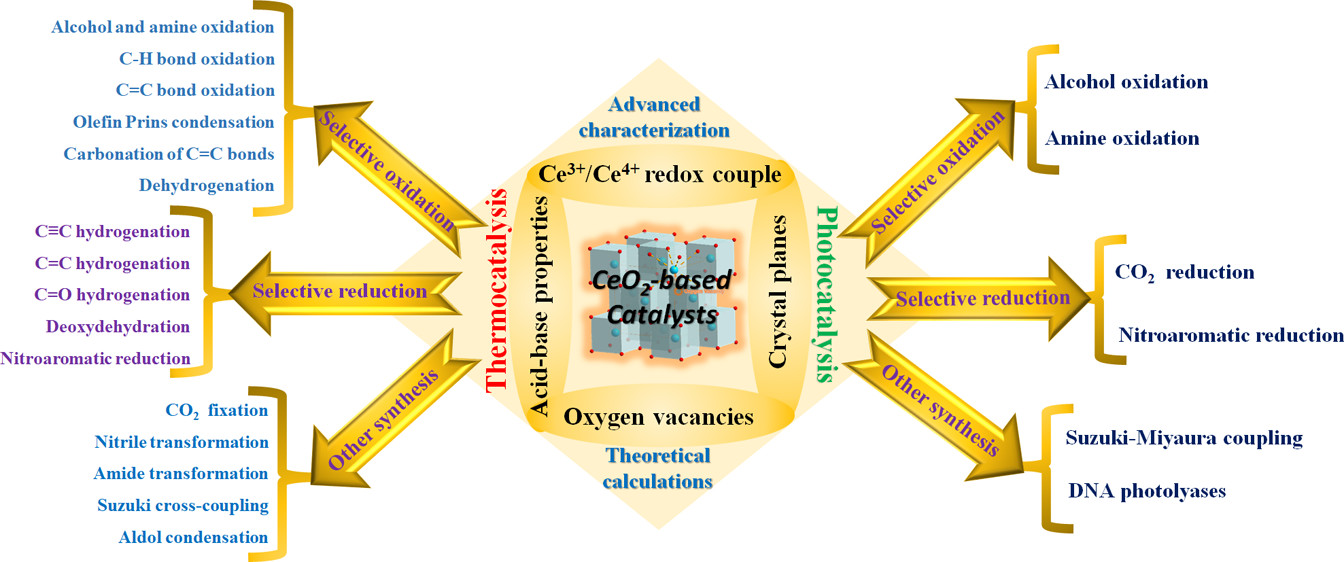
Xiubing Huang*, Kaiyue Zhang, Baoxiang Peng, Ge Wang*, Martin Muhler*, and Feng Wang*
ACS Catal., 2021, 11, 9618-9678
Value-added chemicals, fuels, and pharmaceuticals synthesized by organic transformation from raw materials via catalytic techniques have attracted enormous attention in the past few decades. Heterogeneous catalysts with high stability, long cycling life, good environmental-friendliness, and economic efficiency are greatly desired to accomplish the catalytic organic transformations. With the advantages of reversible Ce3+/Ce4+ redox pairs, tailorable oxygen vacancies, and surface acid–base properties, ceria-based catalysts have been actively investigated in the fields of catalytic organic synthesis. In this Review, we summarize the fundamentals and latest applications of ceria-based heterogeneous catalysts for organic transformations via thermocatalytic and photocatalytic routes.
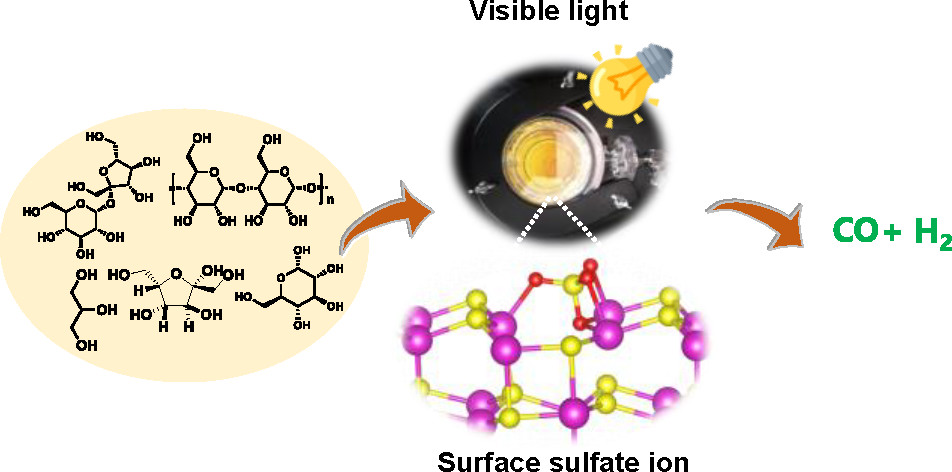
Zhe Zhang, Min Wang*, Hongru Zhou, and Feng Wang*
J. Am. Chem. Soc., 2021, 143, 6533-6541
Photocatalytic biomass conversion represents an ideal way of generating syngas because of the sustainable use of biomass carbon and solar energy. However, the lack of efficient electron–proton transfer limits its efficiency. We here report an unprecedented method to simultaneously increase both the electron and proton transfer by creating surface sulfate ions on the CdS catalyst ([SO4]/CdS). Surface sulfate ion [SO4] is bifunctional, serving as the proton acceptor to promote proton transfer, and increasing the oxidation potential of the valence band to enhance electron transfer...
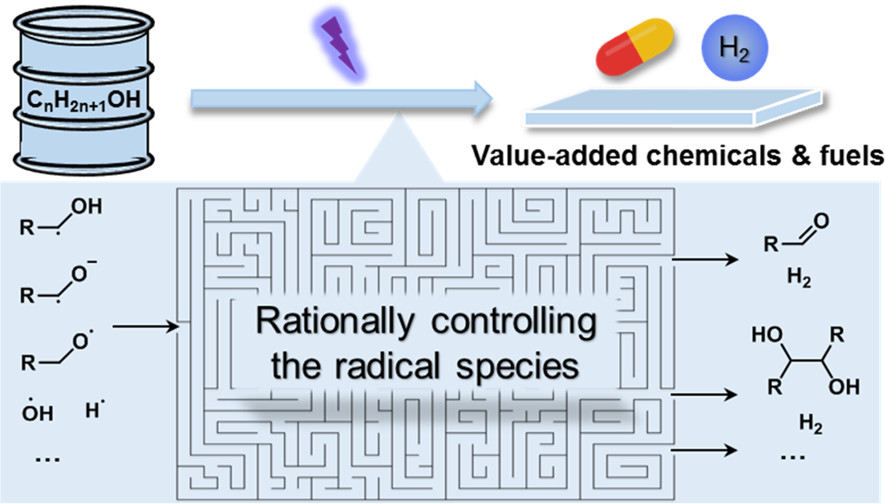
Zhuyan Gao, Nengchao Luo*, Zhipeng Huang, Stuart H. Taylor, and Feng Wang*
ACS Sustain. Chem. Eng., 2021, 9, 6188-6202
Low-carbon number alcohols (LCNAs) are important platform molecules that can be derived from many resources, such as coal, oil, natural gas, biomass, and CO2, creating a route to value-added chemicals and fuels. Semiconductor photocatalysis provides a novel method for converting LCNAs into a variety of downstream products. Photocatalysis is initiated by light-excited charge carriers that are highly oxidative and reductive. The polarity and bond dissociation energy (BDE) of Cα–H bonds are small for alcohols, so it can be homolytically dissociated by the participation of photogenerated holes. Consequently, photocatalytic LCNA conversion overcomes the challenge of Cα–H bond activation in thermocatalysis. Apart from carbon radicals generated from Cα–H bond cleavage, many other radicals are formed during photocatalysis, which are active and have multiple conversion pathways, resulting in complex product distributions...
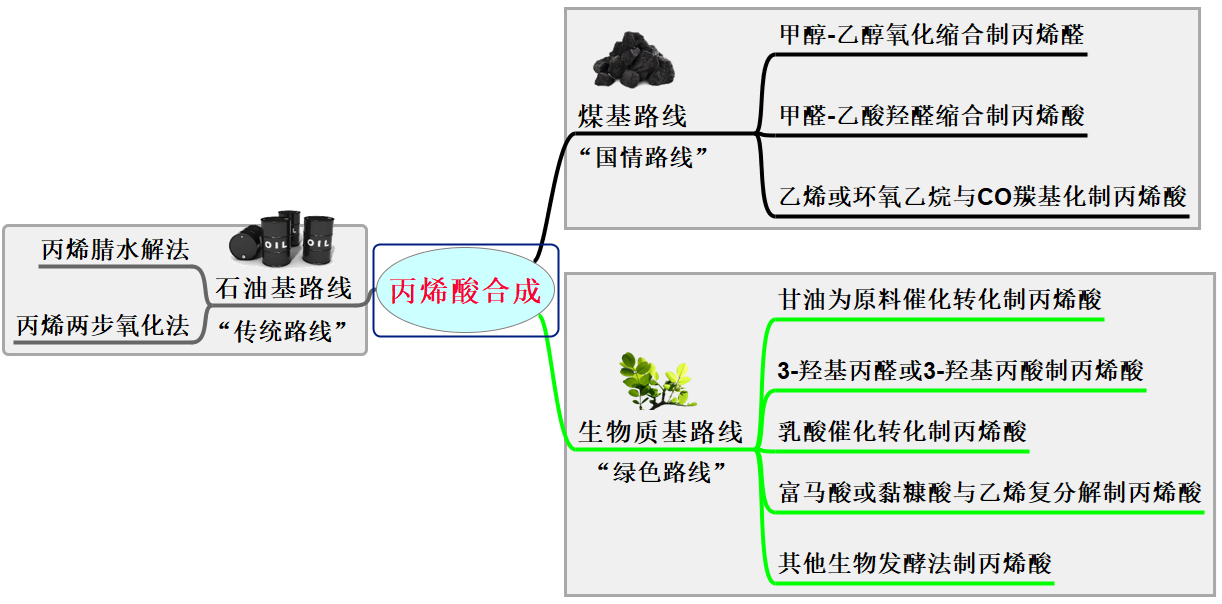
Zhixin Zhang*, Yehong Wang, Chaofeng Zhang, Feng Wang*
Chem. Ind.& Eng. Prog., 2021, 40, 2016-2033
Acrylic acid (AA) is an important industrial chemical intermediate and polymer monomer, which is in great demand. The rich coal resources and renewable biomass resources in China provide a solid material guarantee for the coal-based and biomass-based synthesis routes of acrylic acid. The two main routes were reviewed, including the synthesis routes of acrylic acid from coal-based chemicals, such as CO, low carbon alcohols (methanol and ethanol), formaldehyde, acetic acid, ethylene, and so on, and the synthesis routes of acrylic acid using glycerol, 3-hydroxypropionic acid, lactic acid, fumaric acid, and muconic acid. These routes are compared to provide a reference for the route selection...

Jinghua An, Zhuyan Gao, Yehong Wang, Zhixin Zhang, Jian Zhang, Lu Li, Bo Tang, Feng Wang*
Green Chem., 2021, 23, 2722-2728
Synthesizing amines via the hydroaminomethylation (HAM) reaction of olefins, a multicomponent reaction, has been regarded as one of the most attractive methods compared with the traditional methods considering the atom economy and environmental friendliness. However, the use of homogeneous catalysts, complex ligands containing diphosphine or nitrogen, and base or acid additives has severely hampered the utilization of these methods. Herein, an efficient heterogeneous Ru/TiO2-catalyzed HAM reaction of olefins is developed without any additives. Various amines, including secondary and tertiary amines, can be successfully obtained from olefins including aromatic and aliphatic olefins. Systematic studies demonstrate the lower electron density of Ruδ+ and the higher number of acid sites of Ru/TiO2, leading to the high HAM reaction activity of olefins. Most importantly, nitrobenzene derivatives can also be transformed to the corresponding products over Ru/TiO2 in excellent yields.
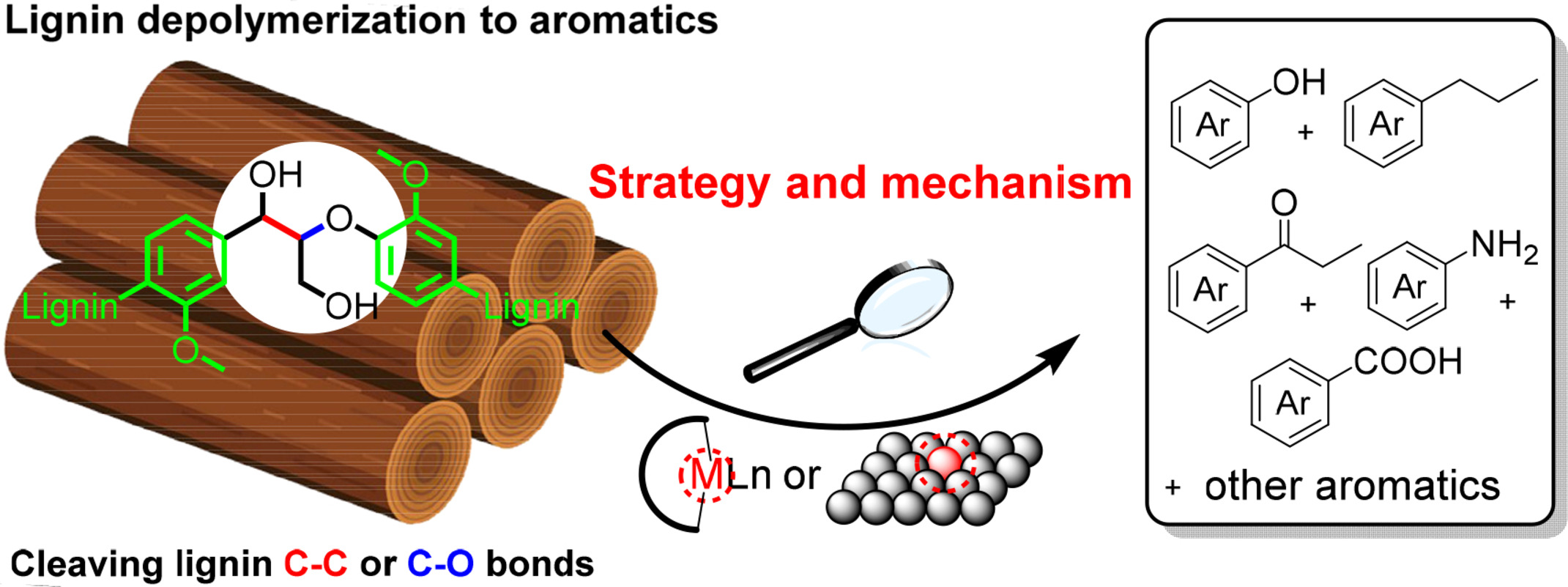
Chaofeng Zhang, Feng Wang*
Elsevier, 2021, 77, 175-218
In this chapter, focusing on lignin catalytic depolymerization to aromatic chemicals, we herein first provide our understanding about the scientific question and strategic foundation process in lignin depolymerization, and then clarify them by mainly presenting our recent studies. Firstly, we introduce our research on direct protolignin depolymerization via a fragmentation–hydrogenolysis process in alcohol solvents. Then, focusing on the catalytic cleavage of lignin C-C and C-O bonds, we shed light on a recapitulative adjacent functional group modification (AFGM) strategy for the conversion of lignin models and apply the established methods in the real lignin conversion via a bottom-up research approach......
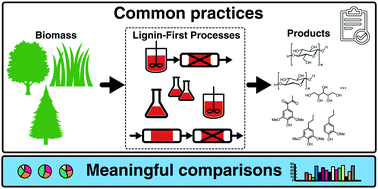
Mahdi M. Abu-Omar, Katalin Barta, Gregg T. Beckham*, Jeremy S. Luterbacher*, John Ralph*, Roberto Rinaldi, Yuriy Román-Leshkov, Joseph S. M. Samec*, Bert F. Sels, Feng Wang.
Energy Environ. Sci., 2021, 14, 262-292
We present herein a set of guidelines for analysing critical data from lignin-first approaches, including feedstock analysis and process parameters, with the ambition of uniting the lignin-first research community around a common set of reportable metrics. These guidelines comprise standards and best practices or minimum requirements for feedstock analysis, stressing reporting of the fractionation efficiency, product yields, solvent mass balances, catalyst efficiency, and the requirements for additional reagents such as reducing, oxidising, or capping agents. Our goal is to establish best practices for the research community at large primarily to enable direct comparisons between studies from different laboratories. The use of these guidelines will be helpful for the newcomers to this field and pivotal for further progress in this exciting research area.

Kaiyi Su, Huifang Liu, Zhuyan Gao, Paolo Fornasiero*, Feng Wang*
Adv. Sci., 2021, 8, 2003156
Niobium pentoxide (Nb2O5), a typically nontoxic metal oxide, is eco‐friendly and exhibits strong oxidation ability, and has attracted considerable attention from researchers. Furthermore, unique Lewis acid sites (LASs) and Brønsted acid sites (BASs) are observed on Nb2O5 prepared by different methods. Herein, the recent advances in the synthesis and application of Nb2O5‐based photocatalysts, including the pure Nb2O5, doped Nb2O5, metal species supported on Nb2O5, and other composited Nb2O5 catalysts, are summarized. An overview is provided for the role of size and crystalline phase, unsaturated Nb sites and oxygen vacancies, LASs and BASs, dopants and surface metal species, and heterojunction structure on the Nb2O5‐based catalysts in photocatalysis. Finally, the challenges are also presented, which are possibly overcome by integrating the synthetic methodology, developing novel photoelectric characterization techniques, and a profound understanding of the local structure of Nb2O5.
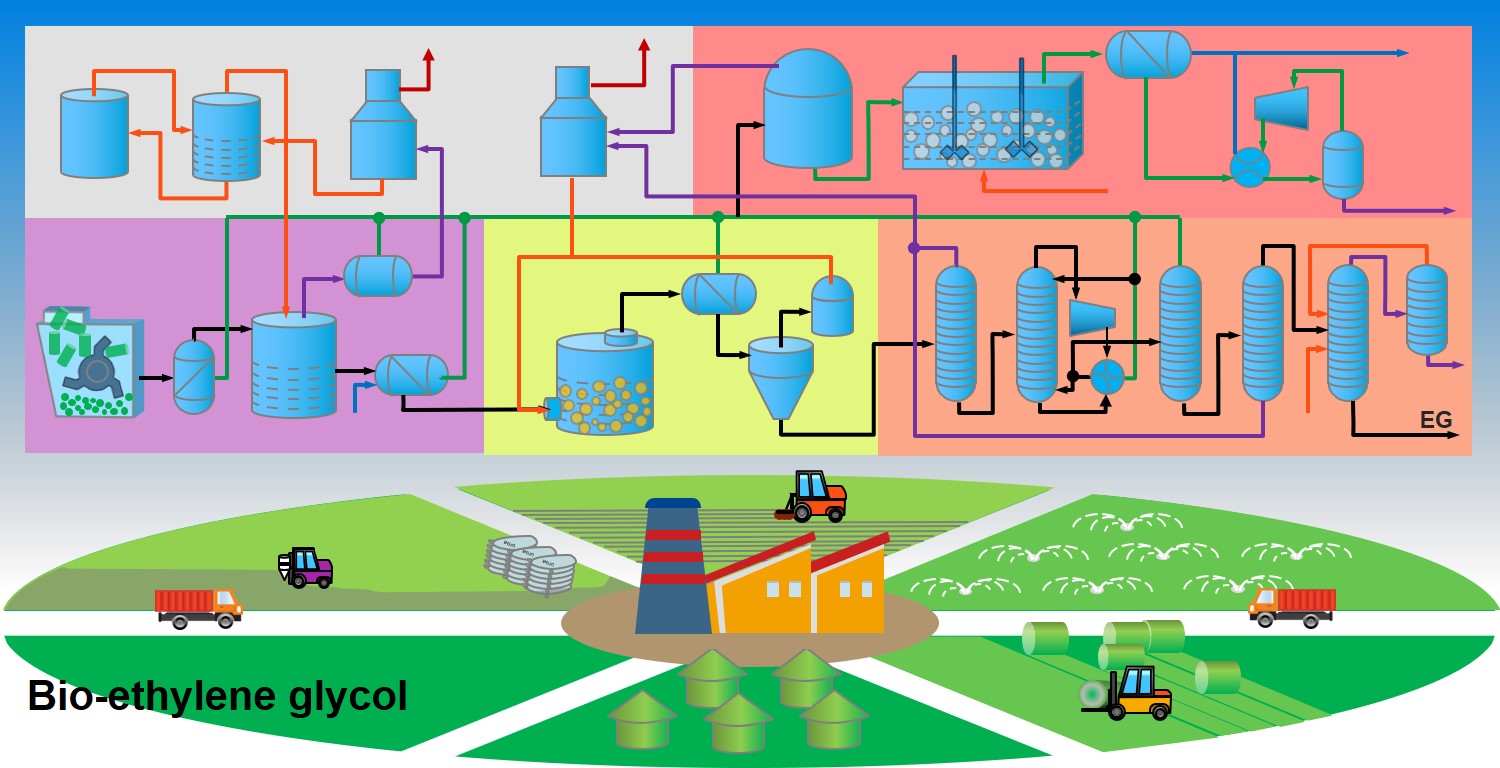
Zhitong Zhao, Jingyang Jiang, Mingyuan Zheng, Feng Wang*
Chem. Eng. J., 2021, 411, 128516
To achieve the economic benefits of bio-EG, research strategies, such as raising the product yield, changing hydrogen sources, increasing feedstock collection efficiency, and lowing water consumption were explored and proved to be effective measures. In addition, a carbon tax of 184 and 598 CNY·t-1 CO2eq are the breakeven points to reach economic benefits of bio-EG compared to petro-EG and coal-EG, respectively. This work aims at conducting a comprehensive evaluation of bio-EG to promote its practical application, and also shedding light on bright prospects and general approaches to develop lignocellulosic biochemicals.

Hongman Sun, Yehong Wang, Shaojun Xu, Ahmed I. Osman, Gavin Stenning, Jianyu Han, Shuzhuang Sun, David Rooney, Paul T. Williams*, Feng Wang*, Chunfei Wu*
Fuel, 2021, 286, 119308:1-8
The distance between catalytic sites (Ni) and sorbents (CaO) on the performance of integrated CO2 capture and utilization (ICCU) process is crucial important because the sorbents demonstrate a dramatic volume increase during carbonation reaction (1st stage of ICCU) and sequentially cover the catalytic sites and retard the CO2 conversion (2nd stage of ICCU). Herein, we synthesized various Ni/CaO-based dual functional materials (DFMs) with different distances between active sites and sorbents to provide different volume spaces for the growth of CaCO3 during the carbonation reaction. It is found that both 1%NiCaO and 10%NiCaO synthesized by a one-pot method exhibited a low CO2 conversion (38% and 45%, respectively) and CH4 selectivity (58% and 69%, respectively) as the distance between catalytic sites and sorbents was so close that the Ni active sites were covered by the formed CaCO3 during carbonation reaction......
Zhitong Zhao, Jingyang Jiang*, Feng Wang*
J. Energy Chem., 2021, 56, 193-202
A comprehensive economic analysis of twenty light olefin production pathways has been performed, covering current and promising processes from fossil (petroleum, coal and natural gas) and renewable resources (biomass and CO2). Taking steam cracking of naphtha as the benchmark, this study gives an economic perspective and points out the bottleneck in different olefin production pathways. The assessment indicates that nearly all renewable pathways are economically unattractive currently and the raw material cost accounts for dominant contribution in most pathways, especially in the oil-, natural gas- and CO2-derived pathways. More details......